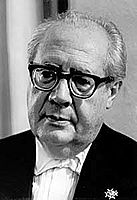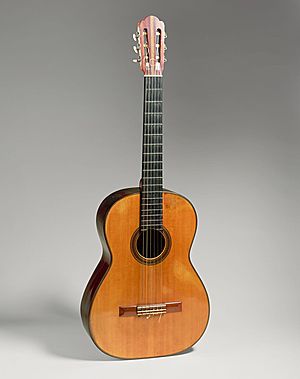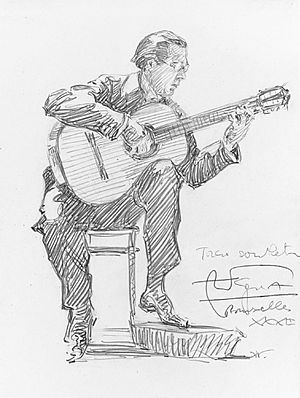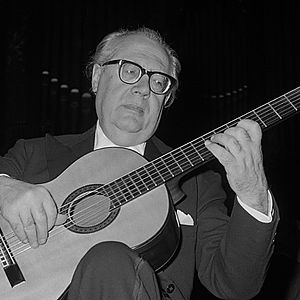Andrés Segovia facts for kids
Quick facts for kids
The Most Illustrious
Andrés Segovia
|
|
|---|---|

Segovia in 1963
|
|
| Background information | |
| Birth name | Andrés Segovia Torres |
| Born | 21 February 1893 Linares, Jaén, Spain |
| Died | 2 June 1987 (aged 94) Madrid, Spain |
| Genres | Classical |
| Occupation(s) | Musician |
| Instruments | Guitar |
| Years active | 1909–1987 |
| Labels | RCA |
Andrés Segovia Torres (born February 21, 1893 – died June 2, 1987) was a famous Spanish classical guitarist. He was known for his amazing skill and for making the classical guitar popular around the world. Many top classical guitarists today were taught by Segovia or by his students.
Segovia helped create new music for the guitar. He also arranged old classical and baroque songs for the guitar. People remember him for his emotional performances and his unique style.
Contents
Early Life and Music
Andrés Segovia was born in Linares, Spain, in 1893. He lived with his aunt and uncle from a young age. His uncle noticed his talent for music and arranged violin lessons. However, Segovia did not like the strict teacher.
Later, his uncle moved to Granada for Segovia's education. Segovia started studying music again. He learned a lot on his own, acting as both teacher and student. He preferred classical music over flamenco, even though flamenco was popular where he grew up.
A Guitar Star's Journey
Segovia gave his first public concert in Granada when he was 16. A few years later, he played his first professional concert in Madrid. He played music by other composers and his own guitar versions of Johann Sebastian Bach's works. His family wanted him to be a lawyer, but he kept studying the guitar.
He performed in Paris in 1915 and Barcelona in 1916. In 1919, he had a successful tour in South America. Segovia helped bring the guitar back into the spotlight as a concert instrument. He used his strong personality and artistic skill to make the guitar popular again. This was helped by new ways of recording music and broadcasting it.
In Paris, Segovia met composer Alexandre Tansman in 1921. Tansman later wrote guitar pieces for him. Segovia also met Agustín Barrios in Argentina that same year. Barrios's piece La Catedral impressed Segovia.
In 1923, Segovia visited Mexico. Composer Manuel Ponce was so impressed that he wrote many works for Segovia. Segovia also visited German guitar maker Hermann Hauser Sr. in 1924. Hauser made a guitar for Segovia in 1928, which Segovia used for many years.
Segovia's first American tour was in 1928. After this tour, the Brazilian composer Heitor Villa-Lobos wrote his famous Twelve Études for guitar and dedicated them to Segovia. They had a lasting friendship, and Villa-Lobos continued to write for him.
In 1932, Segovia met composer Mario Castelnuovo-Tedesco in Venice. Segovia helped him learn about guitar music. Castelnuovo-Tedesco then wrote many pieces for the guitar, dedicating them to Segovia. His Concerto Op. 99 was the first guitar concerto of the 20th century. Segovia performed it for the first time in Uruguay in 1939.
In 1935, Segovia performed Bach's difficult Chaconne for the first time in public. He lived in Montevideo and gave many concerts in South America during the 1930s and early 1940s.
After World War II, Segovia started recording more often. He toured Europe and America regularly for 30 years. In 1954, Joaquín Rodrigo dedicated his Fantasía para un gentilhombre (Fantasy for a Gentleman) to Segovia. Segovia won a Grammy Award in 1958 for his recording Segovia Golden Jubilee.
King Juan Carlos I of Spain honored Segovia in 1981. He gave Segovia the special title of Marquis of Salobreña for his contributions to music. Segovia continued to perform even when he was very old. Two films were made about his life. He passed away in Madrid in 1987 at the age of 94. He is buried in Linares, his hometown.
How Segovia Played
Segovia's right-hand technique was very important for the guitar's sound. He used his fingernails to pluck the strings. This allowed him to create many different sounds and colors in his music. He placed his hand so that his nails were straight against the strings. This helped him avoid unwanted noises from the lower strings.
Segovia also created a strong bass sound with his right thumb. He could move his thumb very flexibly, which helped him make deep, full sounds. He also placed his right hand further to the right side of the guitar. This created a strong, clear sound that could fill large concert halls. Before him, many guitarists played closer to the soundhole, which made a softer sound.
After World War II, Segovia was one of the first to use nylon strings. Before this, guitars used strings made from animal gut. Nylon strings made the guitar sound more stable and helped standardize the instrument.
What Segovia Played
Segovia's music choices came from three main areas:
- New music: Many pieces, including concertos and sonatas, were written especially for him by composers like Federico Moreno Torroba, Manuel Ponce, Mario Castelnuovo-Tedesco, and Heitor Villa-Lobos.
- Arrangements: Segovia often took classical pieces written for other instruments, like the lute or piano, and arranged them for the guitar. He did this for works by Johann Sebastian Bach and Isaac Albéniz.
- Traditional guitar music: He also played older classical guitar pieces by composers like Fernando Sor and Francisco Tárrega.
Segovia loved music from the early 20th century, especially Spanish romantic and nationalist styles. He only played music that he truly connected with. He would sometimes turn down pieces if he felt they were too modern or didn't fit his style.
Teaching Others
Segovia believed that teaching was important for spreading the love of the guitar. He gave many master classes throughout his career. His most famous classes were in Santiago de Compostela, Spain.
Some of his former students, like John Williams, felt that Segovia was very strict. They said he wanted students to play only in his style and didn't encourage them to develop their own.
His Lasting Impact
Segovia played a huge role in making the guitar a respected concert instrument. He showed that the guitar could express deep emotions and be taken seriously in the music world. Before him, many people saw the guitar as just a simple instrument for home entertainment.
In Linares, his hometown, there is a museum called "Fundación Andrés Segovia." There is also a bronze statue of him. Segovia inspired many classical guitarists who came after him, including Christopher Parkening, Julian Bream, and John Williams. They all say they learned a lot from him.
Segovia also left behind many edited music pieces and arrangements for the classical guitar. He made famous arrangements of Bach's works, including the very challenging Chaconne.
Named After Him
- An asteroid, 3822 Segovia, was named in his honor in 1989.
- A guitar competition co-sponsored by the European Guitar Teachers Association is named after Segovia.
Awards and Honors
Segovia received many awards and honors. He was given honorary degrees from ten universities. In 1981, King Juan Carlos I made him the Marquis of Salobreña for his contributions to music and art. He also won the Danish Sonning Award in 1974, the Ernst von Siemens Music Prize in 1985, and a Grammy Lifetime Achievement Award in 1986.
Personal Life
Andrés Segovia was married three times. His first wife was Adelaida Portillo. His second wife was the pianist Paquita Madriguera. In 1962, he married Emilia Magdalena Corral Sancho. They had one son, Carlos Andrés Segovia.
Students
Segovia taught many famous guitarists:
- Lily Afshar
- Liona Boyd
- Julian Bream
- Charlie Byrd
- Abel Carlevaro
- Michael Chapdelaine
- Charo
- Alirio Díaz
- Eliot Fisk
- Oscar Ghiglia
- Adam Holzman (guitarist)
- Michael Laucke
- Antonio Membrado
- Christopher Parkening
- George Sakellariou (guitarist)
- John Williams
See Also
 In Spanish: Andrés Segovia para niños
In Spanish: Andrés Segovia para niños
- Michele Pittaluga International Classical Guitar Competition, founded with his support




